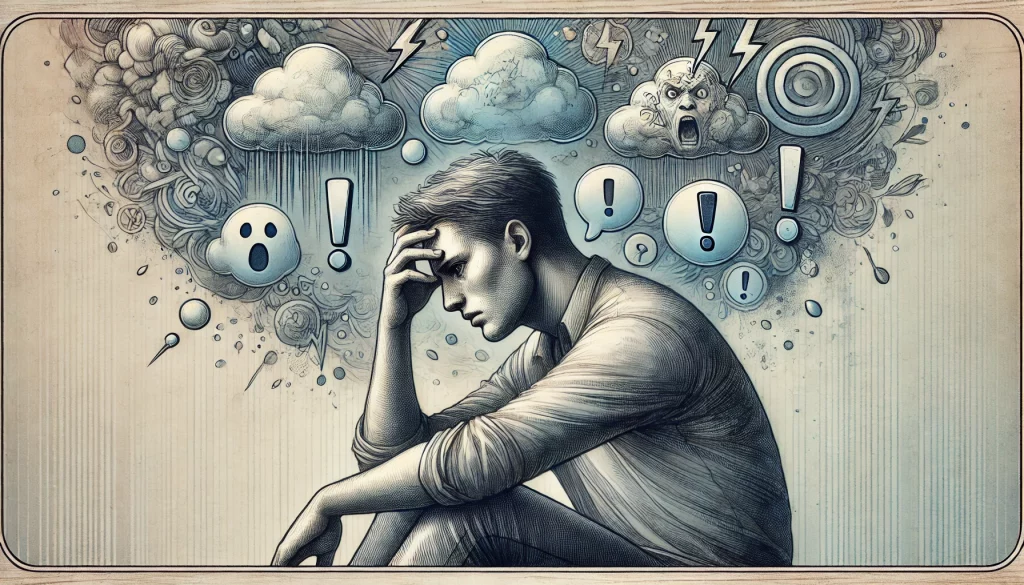
What Are Intrusive Thoughts?
Intrusive thoughts are unwanted, involuntary thoughts, images, or urges that suddenly pop into our minds. They can feel random, unsettling, or even bizarre, often leaving us wondering, Why did I think that?
These thoughts come in many forms and happen to almost everyone at some point. They don’t reflect who we are or what we truly want—they are just noisy interruptions in the mind. Understanding their varieties can help us recognize them as harmless mental blips, not reflections of reality.


Common Types of Intrusive Thoughts
Here are a few common categories of intrusive thoughts people experience:
- Fear of Harm
- Thoughts about accidentally hurting someone or yourself, even though you’d never act on them.
- Example: Imagine dropping something heavy on a loved one, even though you’d never want that to happen.
- Morally Questionable Thoughts
- Thoughts that go against your personal values or beliefs.
- Example: Thinking, What if I steal this item? Even though you’re a law-abiding person.
- Health-Related Thoughts
- Fears of getting a disease or constant worry about physical symptoms.
- Example: Thinking, This headache must mean I have a brain tumor.
- Religious or Existential Thoughts
- Thoughts about questioning your faith, the meaning of life, or the afterlife.
- Example: What if there’s no purpose to life?
A Short Story: Jake and the Bridge
Jake loved his morning runs. The fresh air, the rhythmic sound of his shoes on the pavement, and the sense of accomplishment kept him going. But today, as he jogged toward the old bridge that crossed the river, an unexpected thought struck him out of nowhere:
What if I jumped off this bridge?

Jake froze mid-step. His heart started racing, not from the running but from the sheer panic the thought triggered. He wasn’t sad or feeling down and certainly didn’t want to hurt himself. So why had his brain conjured something so horrifying?
He tried to shake it off, but as he walked across the bridge, the thought came back: What if I lose control and… jump?
The thought felt loud and intrusive, like an uninvited guest crashing his peaceful morning. Jake’s mind spiraled. Why am I thinking this? Is there something wrong with me? What if I actually do it?
By the time he reached the other side of the bridge, he felt exhausted—not from the run, but from battling his own mind. The rest of the day, he couldn’t shake the thought. It made him feel scared and ashamed.
That evening, Jake decided to call his older sister, Emily, someone he trusted with his worries. Hesitantly, he told her about his thoughts on the bridge.
Emily listened patiently and then said, “Jake, I’m so glad you told me this. What you’re describing is an intrusive thought, and I promise it doesn’t mean anything about you.”



Jake frowned. “But it felt so real… What if I really lose control?”
Emily reassured him. “That’s how intrusive thoughts work. They’re like a prank your brain plays on you—completely random, often about things you’d never actually do. The more you worry about them, the more they stick. But they’re just thoughts, Jake. Nothing more.”
She told him about a time she’d had a similar thought—while standing on a subway platform, she’d suddenly imagined stepping onto the tracks. It terrified her, too, but over time she learned that intrusive thoughts are normal and harmless. They don’t reflect who you are; they’re just noise.
The next day, Jake went for another run. As he approached the bridge, the thought popped up again: What if I jump?
But this time, Jake paused, took a deep breath, and said to himself, That’s just an intrusive thought. It’s not me, and it’s not real.
He kept running. The thought lingered for a few moments, but without his fear fueling it, it faded like a cloud drifting out of view. Jake smiled to himself—he wasn’t his thoughts. He was in control of his story, which was moving forward.

Takeaway
Intrusive thoughts can be scary, but they’re not dangerous or meaningful. They’re just mental hiccups—random blips that don’t reflect who you are. Like Jake, you can learn to recognize, label, and let them pass without giving them power. You are not your intrusive thoughts—you are so much more.
How to Handle Intrusive Thoughts
If you’ve ever had an intrusive thought and wondered what to do, here are a few steps:
- Recognize It: Understand that it’s just a thought, not a reflection of who you are.
- Don’t Fight It: The harder you try to push the thought away, the more it sticks. Acknowledge it without engaging.
- Label It: Say to yourself, That’s an intrusive thought. It’s not me.
- Refocus: Gently shift your attention to something else—a task, a conversation, or a deep breath.
- Seek Help if Needed: If intrusive thoughts feel overwhelming or interfere with daily life, talking to a therapist can make a big difference.
Final Thoughts
Intrusive thoughts can feel scary or strange, but they don’t define you. They’re just mental noise that comes and goes, like background chatter on a busy street. The key is not to give them more importance than they deserve. You can reclaim your peace of mind by understanding and managing these thoughts.
Have you ever experienced an intrusive thought? What helped you handle it? Share your thoughts in the comments below—let’s open up the conversation and support one another!
